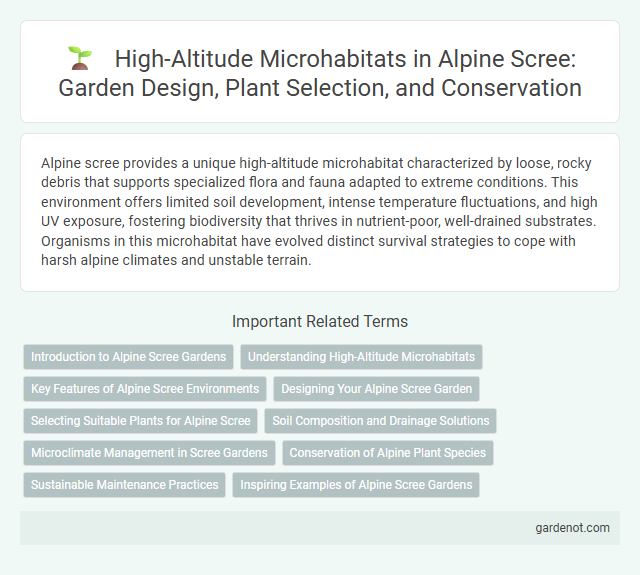Alpine scree provides a unique high-altitude microhabitat characterized by loose, rocky debris that supports specialized flora and fauna adapted to extreme conditions. This environment offers limited soil development, intense temperature fluctuations, and high UV exposure, fostering biodiversity that thrives in nutrient-poor, well-drained substrates. Organisms in this microhabitat have evolved distinct survival strategies to cope with harsh alpine climates and unstable terrain.
Introduction to Alpine Scree Gardens
Alpine scree gardens mimic the high-altitude microhabitats characterized by loose, rocky debris and extreme temperature fluctuations crucial for specialized plant species. These gardens replicate the natural drainage and soil composition found in mountainous scree slopes, supporting resilient flora adapted to harsh alpine conditions. Cultivating alpine scree environments promotes biodiversity by providing niches for endemic plants that thrive in nutrient-poor, well-drained substrates.
Understanding High-Altitude Microhabitats
High-altitude microhabitats in alpine scree provide unique environmental conditions characterized by extreme temperature fluctuations, high UV radiation, and limited soil nutrients. These microhabitats support specialized flora and fauna adapted to survive harsh alpine climates, such as cushion plants, lichens, and cold-tolerant invertebrates. Understanding the complex interactions within these microenvironments is essential for predicting species resilience to climate change and the preservation of alpine biodiversity.
Key Features of Alpine Scree Environments
Alpine scree environments are characterized by loose, angular rock fragments that create unstable substrates critical for specialized high-altitude microhabitats. These areas exhibit extreme temperature fluctuations, high solar radiation, and limited soil development, fostering unique plant and animal adaptations for survival. Key features include rapid drainage, sparse organic material, and microclimatic niches that support biodiversity in harsh alpine conditions.
Designing Your Alpine Scree Garden
Creating an alpine scree garden involves selecting high-altitude microhabitats that mimic natural rocky slopes with excellent drainage and minimal soil. Focus on incorporating drought-tolerant plants such as saxifrages, sedums, and alpine asters, which thrive in well-drained, nutrient-poor conditions typical of scree environments. Position rocks strategically to retain moisture and provide shelter, enhancing microclimate variability essential for plant survival and growth.
Selecting Suitable Plants for Alpine Scree
Alpine scree provides a challenging high-altitude microhabitat characterized by unstable, rocky substrates with rapid drainage and minimal nutrient availability. Selecting suitable plants involves prioritizing hardy, drought-resistant species such as Saxifraga, Silene, and Sedum, which possess deep root systems to anchor in loose scree and adaptations to extreme temperature fluctuations. These plants enhance soil stability and biodiversity, crucial for sustaining alpine ecosystem resilience in harsh mountain environments.
Soil Composition and Drainage Solutions
Alpine scree microhabitats are characterized by coarse, well-drained soils composed primarily of angular rock fragments and mineral particles, facilitating rapid water infiltration and preventing water stagnation. These soils exhibit low organic content and nutrient availability, demanding specialized plant adaptations to thrive under nutrient-poor conditions. Efficient drainage solutions in these high-altitude environments reduce soil moisture variability, mitigating frost heave and supporting a stable microhabitat for endemic flora and fauna.
Microclimate Management in Scree Gardens
Alpine scree microhabitats exhibit unique microclimate conditions characterized by high diurnal temperature variation and enhanced soil drainage, crucial for the survival of specialized flora. Effective microclimate management in scree gardens involves optimizing substrate composition and rock arrangement to regulate moisture retention and thermal buffering. These interventions mimic natural alpine scree microhabitats, promoting biodiversity and resilience against climate fluctuations.
Conservation of Alpine Plant Species
High-altitude Alpine scree provides a unique microhabitat that supports specialized plant species adapted to extreme conditions such as low temperatures, high UV radiation, and unstable substrate. Conservation of these Alpine plant species requires protecting fragmented scree habitats from climate change impacts and human disturbances like tourism and alpine mining. Effective strategies include monitoring genetic diversity, enforcing habitat preservation policies, and promoting sustainable land management practices in mountainous regions.
Sustainable Maintenance Practices
High-altitude microhabitats in Alpine scree environments demand sustainable maintenance practices to preserve fragile biodiversity and prevent soil erosion. Implementing low-impact trail design and controlled grazing reduces habitat disturbance while promoting natural regeneration. Monitoring temperature fluctuations and moisture retention supports adaptive management strategies for long-term ecosystem resilience.
Inspiring Examples of Alpine Scree Gardens
Alpine scree gardens exemplify high-altitude microhabitats by showcasing resilient plant species like Saxifraga and Androsace that thrive in rocky, well-drained substrates with rapid temperature fluctuations. These gardens mimic natural scree environments found in the European Alps, promoting biodiversity and conservation of endemic flora adapted to extreme conditions. Innovative garden designs incorporate native alpine species to create sustainable landscapes that withstand harsh wind exposure and nutrient-poor soils.
High-altitude microhabitat Infographic

 gardenot.com
gardenot.com